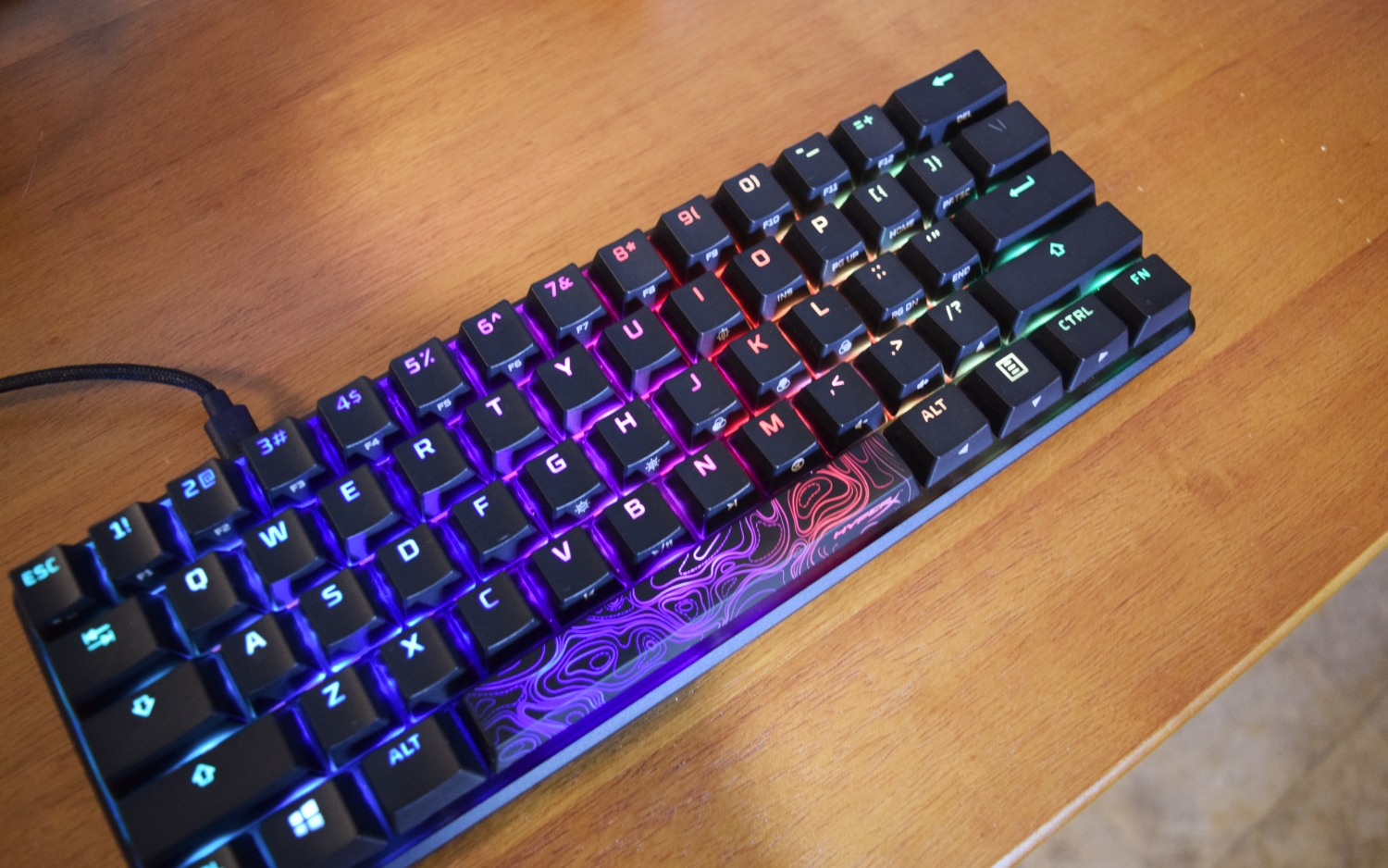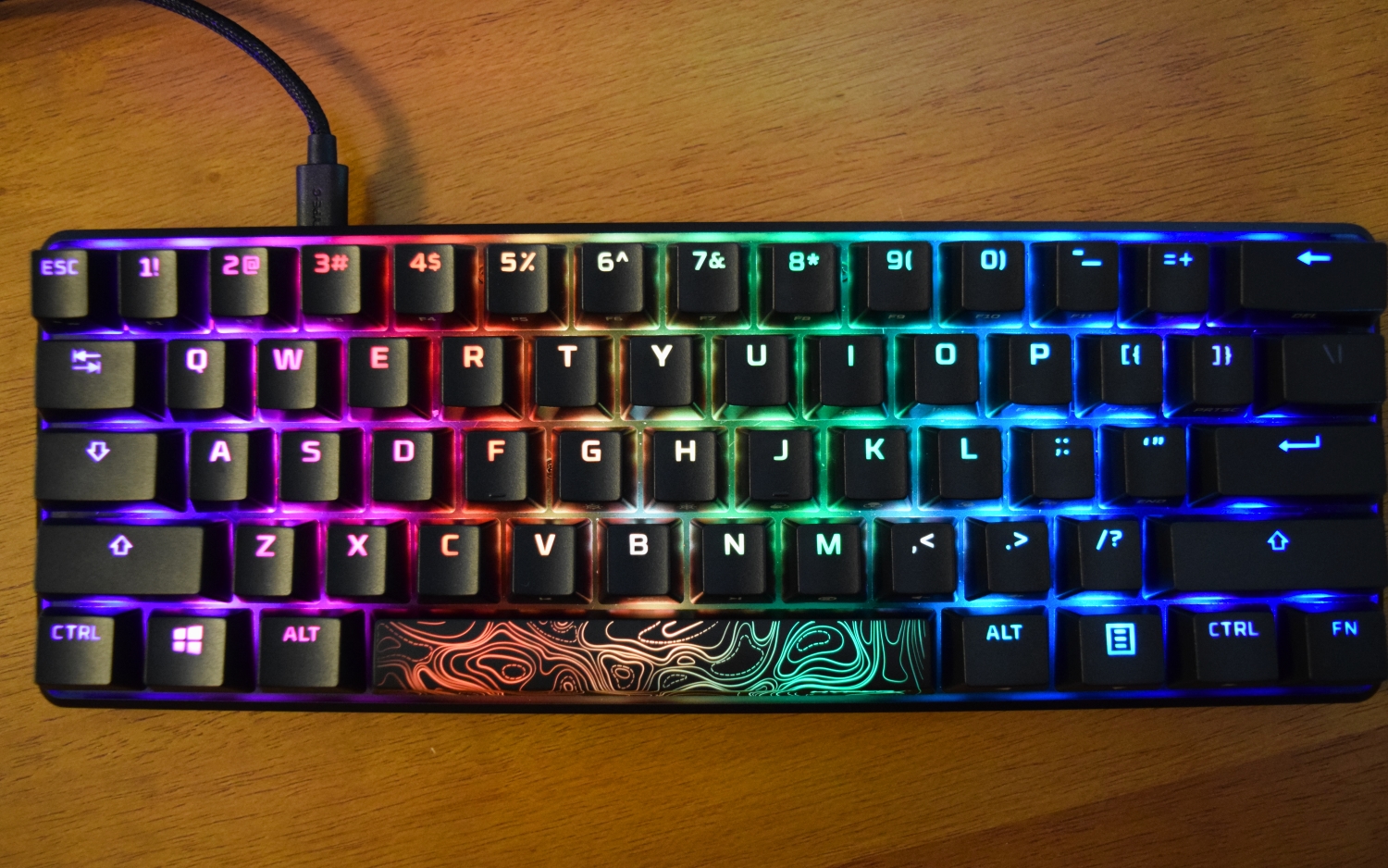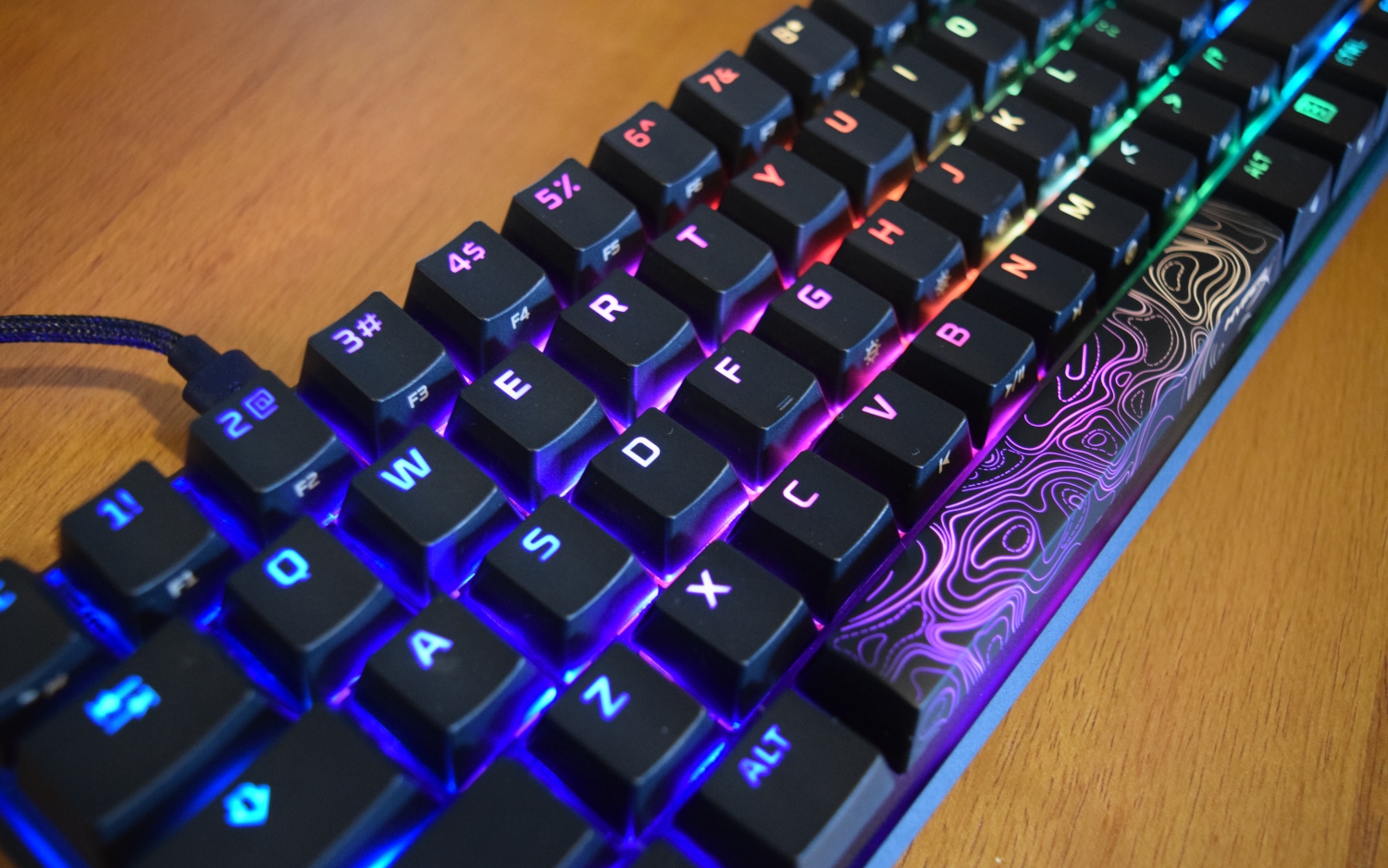Tom's Hardware Verdict
The HyperX Alloy Origins 60 is a 60% gaming keyboard that justifies its premium price tag with sturdy build quality, responsive mechanical switches and RGB backlighting.
Pros
- +
Premium build quality
- +
Doesn’t take up a lot of desk space
- +
Responsive, ping-free switches
Cons
- -
60% layout can be hard to learn
- -
Replacement spacebar uses ABS plastic instead of doubleshot PBT
Why you can trust Tom's Hardware
HyperX entered the 60% form factor market with the almost scandalously named HyperX x Ducky One 2 Mini in May 2020. The limited run keyboard sold out quickly, so HyperX released another model with a few cosmetic changes in November, and that version sold out as well. Now, the company has released the HyperX Alloy Origins 60 ($100) as its first solo entry in the 60% market. Hopefully, the first of its self-described “petite” keyboards to stay in stock for a while because if you’re looking for a small clacker, this is one of the best gaming keyboards you can get.
HyperX Alloy Origins 60 Specs
| Switches | HyperX Red |
| Lighting | Per-key RGB |
| Onboard Storage | 3 profiles |
| Media Keys | With FN |
| Interface | USB Type-C to USB 2.0 Type-A |
| Cable | Detachable, braided |
| Additional Ports | None |
| Keycaps | Doubleshot PBT |
| Construction | Aluminum top plate, plastic base |
| Software | HyperX Ngenuity |
| Dimensions (LxWxH) | 11.5 x 4 x 1.5 inches (292.1 x 101.6 x 38.1mm) |
| Weight | 1.6 pounds (738g) |
| Extra | Spacebar keycap, Esc keycap, keycap puller |
Design
There’s no denying the HyperX x Ducky One 2 Mini’s influence on the Alloy Origins 60. Aside from the lack of Ducky’s branding, the most immediate differentiator is this model’s monochromatic color scheme. HyperX’s first 60% keyboard complemented its predominantly black design with red accents; those accents disappear on the Alloy Origins 60. It’s like the company decided to channel The Rolling Stones by making sure every piece of red was painted black.
Otherwise, the Alloy Origins 60 seems awfully similar to its predecessor. Both were designed with one clear goal in mind: making the smallest keyboard the average gamer might accept. (There are smaller form factors, sure, but those are clearly intended for enthusiasts.) The number pad is gone. So too are the function row, arrow keys and the nine-key cluster that houses the likes of Insert and Delete. Everything has been pared down to bare essentials.
The result is an itty-bitty keyboard that we measured at 11.5 inches long, 4 inches wide and roughly 1.5 inches tall (292.1 x 101.6 x 38.1mm) with a weight of 1.6 pounds (738g) excluding the cable. For comparison, the Razer Huntsman Mini is about 11.6 x 4 x 1.3 inches. The Alloy Origins 60’s dimensions and 1.6-pound (738g) weight combined with the Alloy Origins 60’s aluminum construction, detachable cable, and collapsible feet should make the keyboard easy to travel with. They also mean there’s plenty of room on our desk for your relatively large and best RGB mouse pad, a headset stand and our other, as they say, #gaminggear.
HyperX ships the Alloy Origins 60 with a keycap puller, a replacement Esc key featuring the company’s logo and a unique spacebar that boasts a topographic design. That spacebar is the only key made from ABS plastic; the rest are doubleshot, ensuring the print won’t fade, and more premium type of plastic, PBT. That’s in order to get the unique design on the keyboard, which HyperX told us was selected among about 12 concepts from the design team. Although the dip in construction material is a drawback, we’d be happy to see this trend of highly decorative bonus keycaps take off.
Overall, the Alloy Origins 60’s use of that higher quality plastic, its sturdy aluminum frame and its braided USB cable all make it seem like a truly premium offering that doesn’t rely entirely on RGB lighting to justify its price tag.
Typing Experience
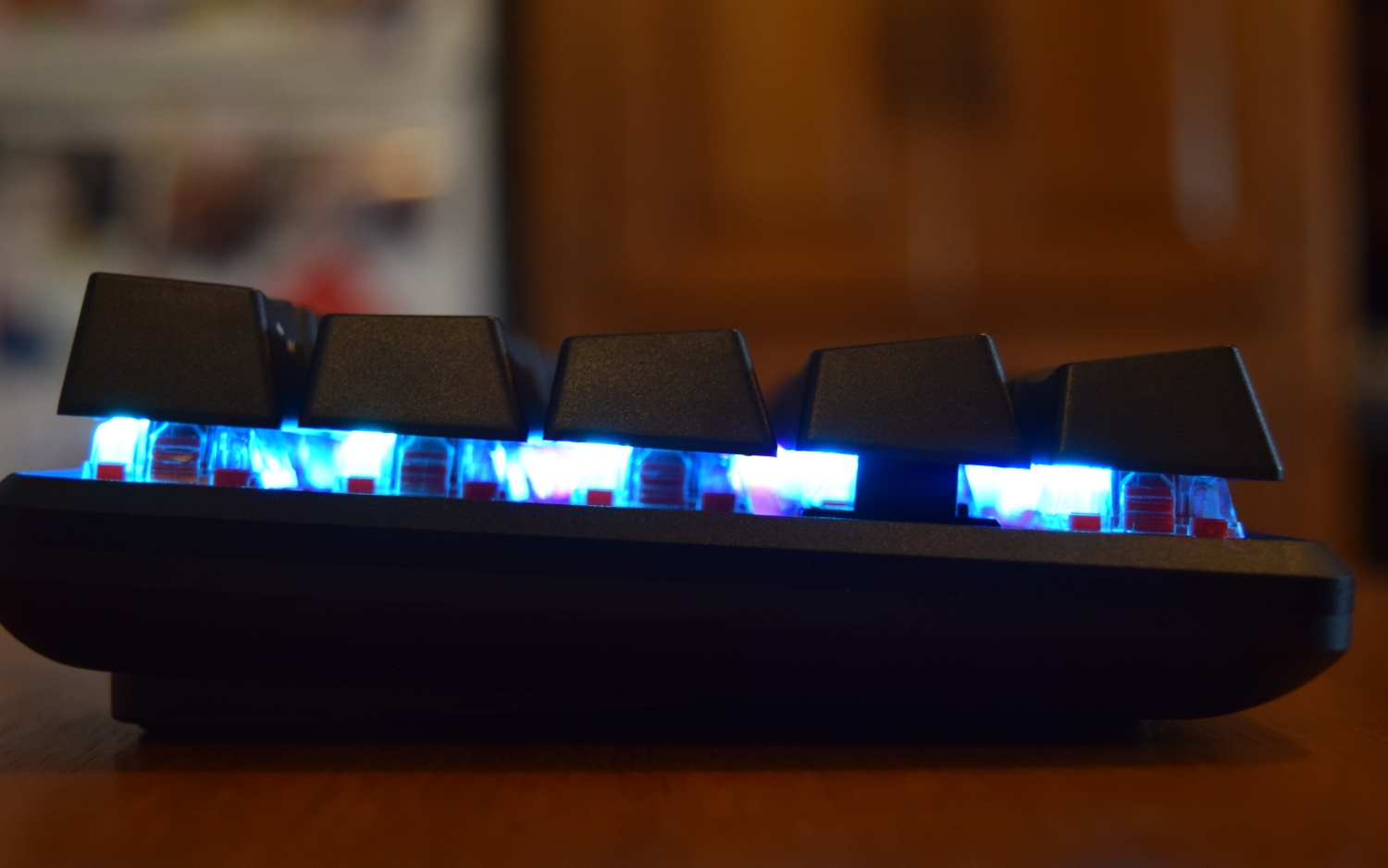

The Alloy Origins 60 ships with linear HyperX Red mechanical switches that feature a 1.8mm actuation point and 3.8mm total travel with 45g actuation force. HyperX offers the same switch, as well as other HyperX ones in the full-sized HyperX Alloy Origins, tenkeyless HyperX Alloy Origins Core and HyperX x Ducky One 2 Mini. Upon release, the Alloy Origins 60 is only available with linear switches, but we wouldn’t be surprised to see HyperX eventually add its tactile Aqua and/or clicky Blue switches as options.
Get Tom's Hardware's best news and in-depth reviews, straight to your inbox.
HyperX Red switches are intended for gaming, but it’s worth considering how they fare during everyday use, too. Most aren’t able to switch keyboards every time they move between work and play.
I used the 10fastfingers.com typing test to quantify my typing performance with the Alloy Origins 60 compared to other keyboards. The average results after three tests were 117 words per minute (wpm) with 97% accuracy. That compares well to my results with the Logitech G Pro, Razer BlackWidow V3 and Apple Magic Keyboard for iPad Pro. I was slightly faster on the Origins 60 than on the G Pro (116.3 wpm) but also slightly less accurate compared to the 97.5% accuracy there.
From a qualitative perspective, however, I had a few problems with the Alloy Origins 60. It turns out that I tend to lightly rest a finger on the E key, and the switches are sensitive enough to register that not-quite-hovering. This resulted in long strings of letters that made it seem like I were typing in chat apps and disrupted my flow while writing. (There’s nothing like having an idea, going to type it and losing it because you have to delete “eeeeeeeeeeeeeeee.”) Of course, your experience may vary. If you have lighter hands, you’ll be okay. For comparison, these switches require the same amount of force to actuate as Cherry MX Red switches, which also have 4mm total travel and actuate at 2.2mm.
It can also be hard to get used to the 60% form factor, especially when it comes to productivity. Having to hold down the Fn key on the bottom-right corner of the keyboard made it difficult to perform certain functions. That difficulty varied by function. Taking a screenshot was simply a matter of finding the PrtSc key, for example, while exiting an app using Alt+F4 was impossible without using both hands. Some might adapt quickly to this new approach; others might never get accustomed to it.
None of these trade-offs are a surprise in a 60% keyboard though. This small form factor is for a specific audience. And the overall experience of typing on the Alloy Origins 60 was pleasant. The flip-out feet prove useful here by offering three different angles (default, slightly propped up and fully propped) at which the keyboard can rest, which should make it easier to fine-tune the ergonomics. Once the keyboard was settled at just the right angle, the keys felt satisfying throughout the entire press.
Meanwhile, the doubleshot PBT keycaps were shaped well enough that we didn’t have to worry about our fingers slipping. HyperX nailed the keycaps’ texture, too, giving the keys just enough grip to ensure stability without feeling like sandpaper beneath our fingers. Bonus points for a lack of undue pinging, which has become an even greater concern throughout the course of the global work from home experiment that kicked off nearly a year ago.
Gaming Experience
This is where the Alloy Origins 60 shines. Linear switches like this are most useful in games where a few milliseconds mean the difference between success and failure. Need to crouch? Just brush your pinky against the “Ctrl” key. Time to reload? That key is “R”-eady to go as well. Those sensitive mechanical switches are supposed to respond as quickly as possible to your touch; who cares if they might lead to lines of “Es” appearing in the heavy-handed’s word processor of choice?
There are lighter mechanical switches though, even linear ones in the 60% form factor. Razer’s Huntsman Mini is available with Razer’s optical mechanical clicky or linear switches. The linear ones actuate with 40g of force compared the Alloy Origin 60 switches’ 45g. Razer’s linear optical switches also have shorter travel( 1.5mm actuation point, 3.5mm total travel) compared to HyperX Reds (1.8mm actuation and 3.8mm total travel).
We found HyperX Reds’ responsiveness particularly helpful in fast-paced games, like Call of Duty: Warzone. That game requires a lot of split-second decision making tied to a lot of inputs. Each fight can require you to walk, sprint and slide; use field upgrades, grenades and tactical equipment; slam open doors, jump through windows and deploy a parachute; and switch weapons or refill armor plates. (To say nothing of actually, you know, shooting at someone.)
It’s also the kind of game where sound matters quite a bit. How are you supposed to listen to your surroundings if every key you press clicks and clacks like a miniature cap gun? And how effectively will you be able to make call outs to your squad if they can barely hear you over the sound of you running, using all your equipment and frantically searching for an “I win” key? The Alloy Origins 60 isn’t silent, but it’s definitely quieter than a lot of other gaming keyboards.
Form factor also plays a role. The entire point of a 60% keyboard is maximizing the amount of desk space available to other peripherals, especially the mouse pad. Using a lower in-game sensitivity makes it easier to aim, generally speaking, and that also requires the use of a larger mousepad. In my experience it’s more comfortable to use a large mousepad with a smaller keyboard so my shoulders don’t have to be spread quite as far apart.
Suffice it to say the Alloy Origins 60 fits the bill. We’d just gotten used to clearing most of our desk to review the full-sized Razer BlackWidow V3 when we unboxed HyperX’s petite savior. The difference is striking. Besides having more desk space for other peripherals, this setup also feels more comfortable, especially during longer sessions. The difference from a tenkeyless keyboard is less pronounced but still noticeable. Ergonomically, 60% feels like the way to go.
Features and Software
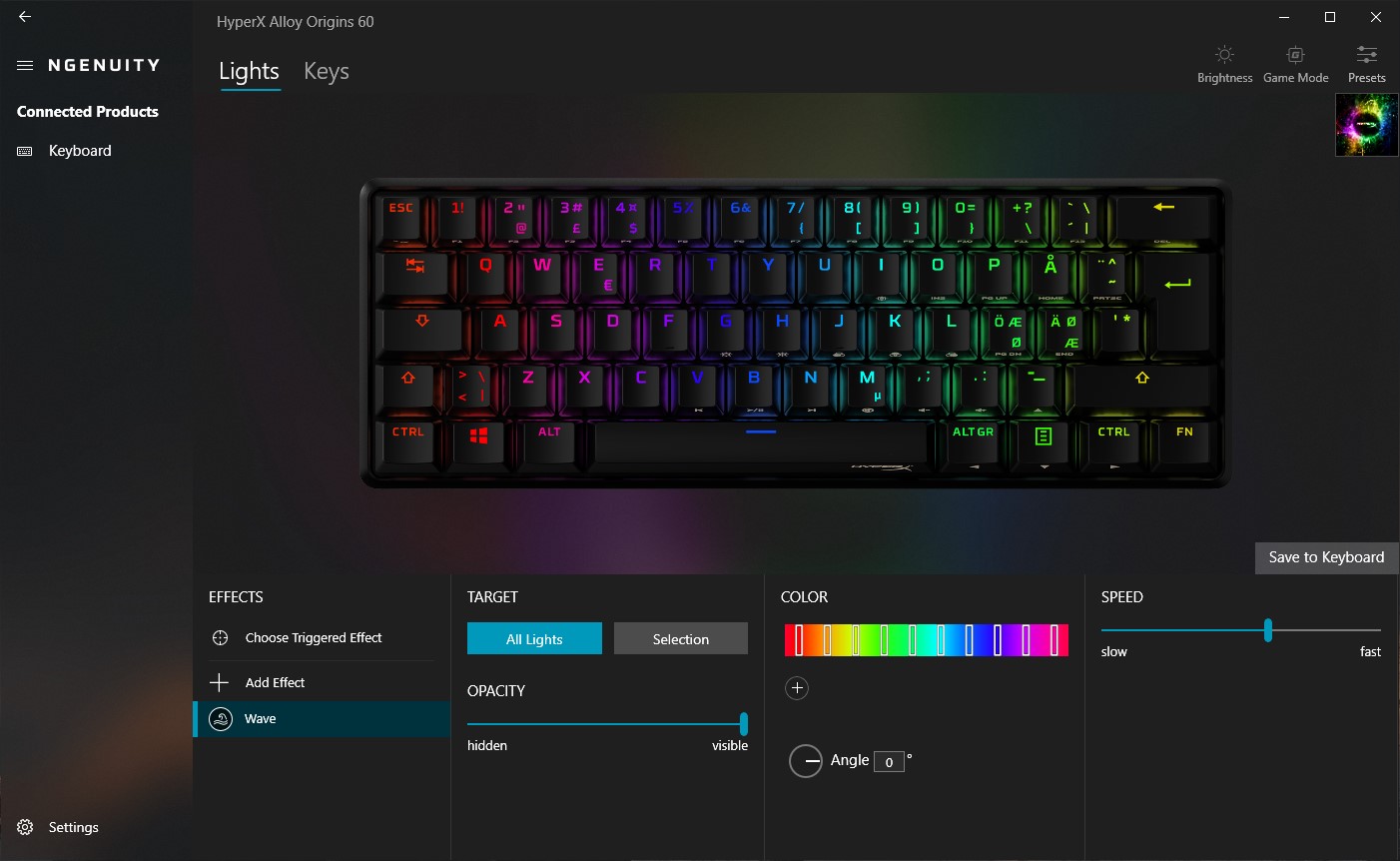


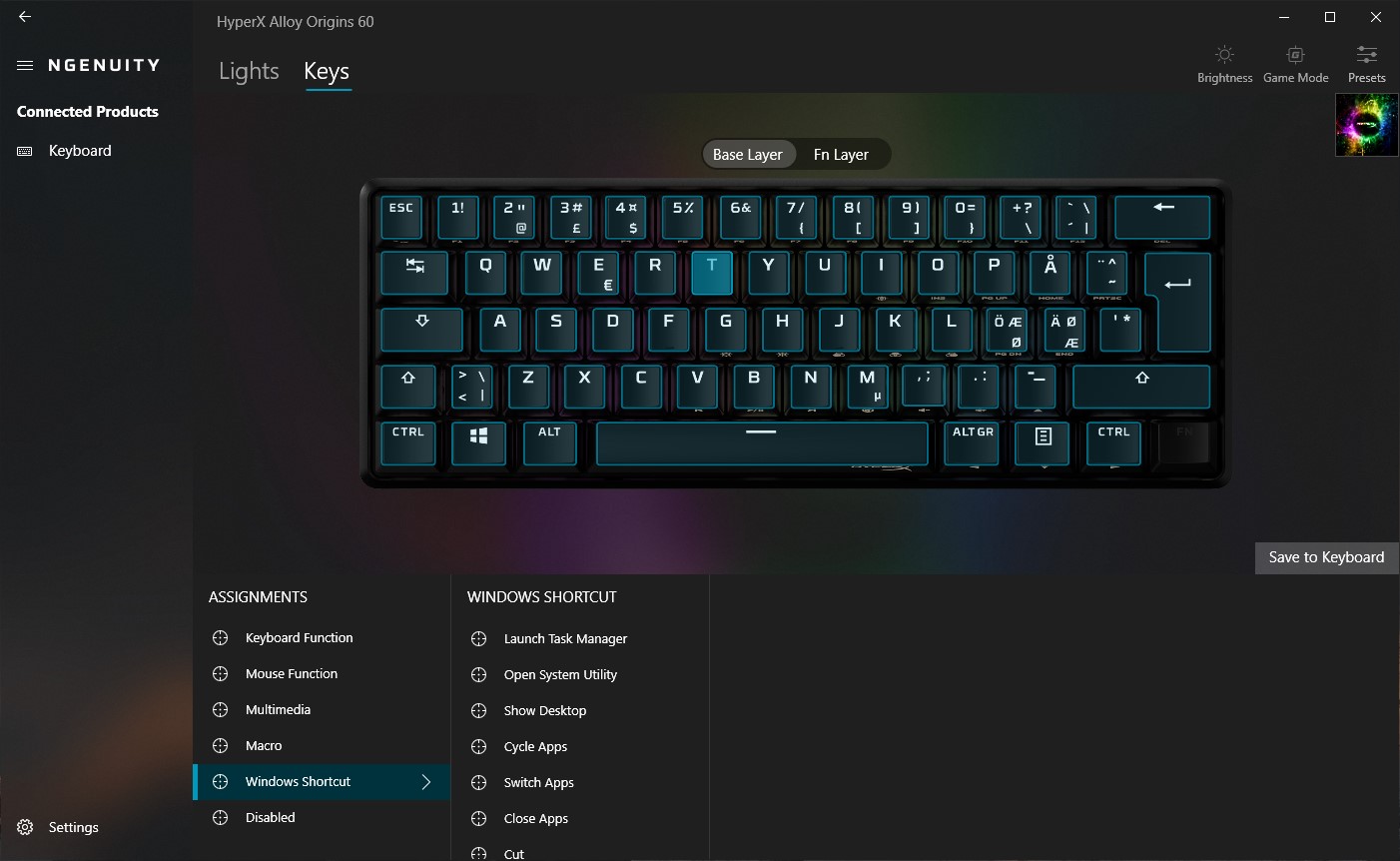

HyperX offers a variety of customization features for the Alloy Origins 60 via its NGenuity software. The app launches right into controls that make it easy to apply new colors, one of seven built-in effects and various cycling speeds to the keyboard’s lighting on a per-key basis (with an “All Lights” button to simplify keyboard-wide changes, of course). You’ll see changes on the keyboard in real-time, but they aren’t saved until you press the “Save to Keyboard” button.
You also need NGenuity to assign new functions to any and all keys. There are a variety of available categories--Mouse Function, Multimedia, Macro and Windows Shortcut. The left Shift key could be used to launch the Task Manager, for example, while the Esc mutes audio. All of these assignments can be assigned to a key on the “Base Layer” or the “Fn Layer” as desired.
The app also offers easy access to brightness settings, preset configurations and a Game Mode that can be used to disable any combination of four different keyboard shortcuts that can ruin a gaming session. (There’s nothing like being in the middle of a match and hitting “Alt”+“Tab” at a critical moment.)
There are three different onboard profiles that can be switched to using NGenuity, via keyboard shortcut, or, if you have NGenuity downloaded, when a specific game is launched.
Bottom Line
As a 60% gaming keyboard, the HyperX Alloy Origins 60 is a niche product. Consumers have become more accustomed to tenkeyless keyboards, but removing even more keys can seem daunting. Living without a number pad is relatively easy compared to living without the function row, arrow keys and other essential keys. For many people the form factor’s trade-offs won’t be worth its benefits.
If you belong to that niche, however, the Alloy Origins 60 is easy to recommend. It has everything we look for in a premium keyboard. That includes a braided, detachable cable that should be easy to transport; a premium build quality resulting from doubleshot PBT keycaps, an aluminum top frame, seemingly reliable mechanical switches and RGB lighting that’s easy to configure. The included keycap puller and the custom spacebar make the keyboard even more appealing.
If you’re looking for something other than linear switches though, you’re currently out of luck. HyperX tends to add more switch options to its Alloy Origins lineup, but the Alloy Origins 60 only has one switch option right now. For an alternative, the Razer Huntsman Mini 60% keyboard offers Razer’s optical mechanical linear or clicky switches.
But if you want linear switches that are quick to respond in a keyboard built with quality in mind, the Alloy Origins 60 is a top contender.

Nathaniel Mott is a freelance news and features writer for Tom's Hardware US, covering breaking news, security, and the silliest aspects of the tech industry.
-
Rich_Morin I looked for information on key rollover, but didn't find any. I'm not a gamer, but I gather that N-key rollover is important to them. In my case, I simply want to sue it as a way to support input of Braille characters.Reply -
bkuhl ReplyRich_Morin said:I looked for information on key rollover, but didn't find any. I'm not a gamer, but I gather that N-key rollover is important to them. In my case, I simply want to sue it as a way to support input of Braille characters.
In their spec sheet:
Petite 60% form factorHyperX mechanical switches1Full aircraft-grade aluminum bodyDouble shot PBT keycaps with side-printed secondary functionsRGB backlit keys with radiant lighting effectsAdvanced customization with HyperX NGENUITY softwareThree adjustable keyboard angles and detachable USB-C cableIncluded keycap puller and additional keycapsOnboard memoryGame Mode, 100% anti-ghosting, and N-key rollover functionalitiesMulti-platform compatibility
